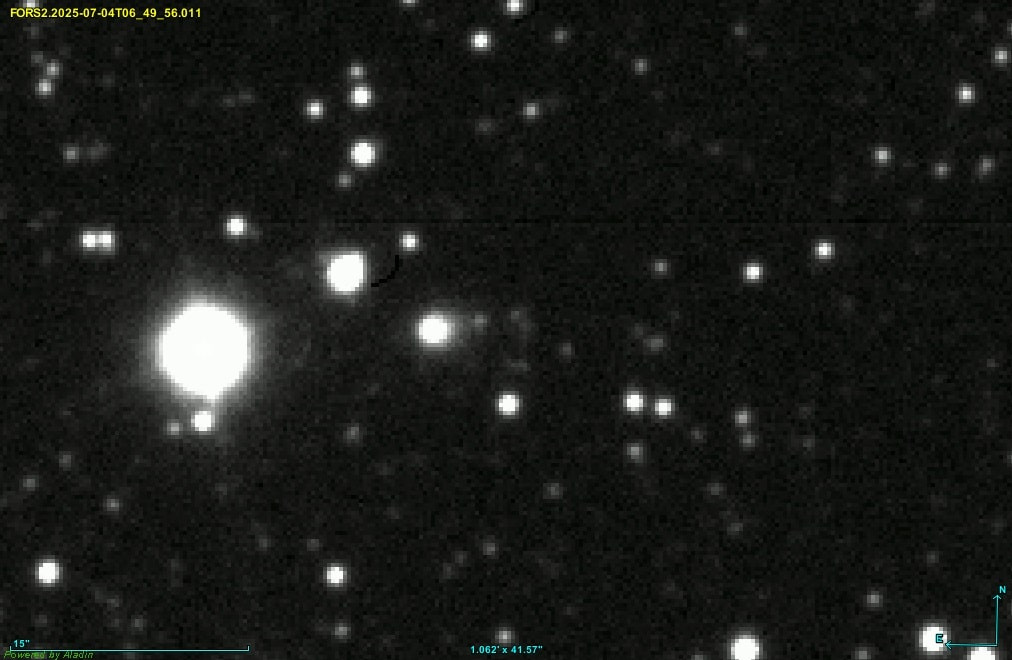
A newly discovered comet, officially designated 3I/ATLAS, has entered our solar system on a hyperbolic trajectory—making it only the third known interstellar object to do so. This cosmic visitor could be the oldest comet ever detected, offering astronomers a rare glimpse into material formed outside our solar system, possibly over 7 billion years ago.
3I/ATLAS was first observed on July 1, 2025, by the ATLAS (Asteroid Terrestrial-impact Last Alert System) survey team operating in Río Hurtado, Chile. This NASA-funded project continuously scans the sky for fast-moving objects that might pose a risk to Earth.
Upon discovery, astronomers quickly analyzed archived images from late June taken by the Zwicky Transient Facility, helping to refine the object’s trajectory. These precovery observations were essential in confirming its interstellar origin, given its hyperbolic orbit with an eccentricity greater than 6 and a speed exceeding 58 km/s, too fast to be gravitationally bound to the Sun.
Unlike its predecessors—1I/ʻOumuamua and 2I/Borisov—3I/ATLAS is both visibly active and significantly larger. Early observations suggest a nucleus possibly 10–20 km wide, enveloped by a faint coma and developing tail, indicating the sublimation of volatile ices as it nears the Sun. Spectroscopic analysis hints at the presence of water vapor and carbon-rich compounds, offering a tantalizing look at the chemical composition of planetary systems outside our own.
What sets this comet apart is its estimated age. Scientists believe 3I/ATLAS originated in the ancient thick disk of the Milky Way, making it possibly over 7 billion years old. If confirmed, this would make it the oldest comet ever studied, predating the solar system itself.
3I/ATLAS is currently traveling through our solar system at an incredible ~130,000 mph. Its trajectory is taking it inward from the direction of the Sagittarius constellation, with perihelion—its closest approach to the Sun—expected around October 29–30, 2025, at a distance of 1.36 AU (just inside the orbit of Mars). It will make its closest approach to Earth on December 19, 2025, at approximately 1.8 AU, which is about 270 million kilometers away.
Although it poses no threat to Earth, it will provide a prime opportunity for observation using both ground-based and space telescopes. Instruments like the James Webb Space Telescope, the upcoming Vera C. Rubin Observatory, and the Very Large Telescope (VLT) are all expected to be part of coordinated international efforts to monitor the object.
The scientific potential of 3I/ATLAS is vast. Unlike ʻOumuamua, which was rocky and showed no visible outgassing, and Borisov, which was smaller and briefly observable, 3I/ATLAS is a large, icy, and long-lived visitor. Its materials remain largely unaltered since the dawn of the galaxy, offering clues about how planetary systems evolve in other parts of the Milky Way.
Astronomers hope to use 3I/ATLAS to study interstellar dust grains, the chemical diversity of comets beyond our solar system, and the dynamics of interstellar travel. As one astronomer put it, “This isn’t just a comet—it’s a message from another star.”
Amateur astronomers may get a chance to view 3I/ATLAS with medium-to-large telescopes beginning in September 2025, especially from dark-sky locations in the Southern Hemisphere. However, its brightness is still uncertain, depending on how actively it outgasses as it approaches the Sun.
3I/ATLAS will become briefly obscured in late October due to solar glare but is expected to reappear in the morning skies by early December, offering a limited but exciting window for observations.
The arrival of 3I/ATLAS is more than just another celestial event—it is a historic scientific opportunity. As a rare interstellar comet, possibly formed long before our Sun was born, it holds secrets from the deepest reaches of the galaxy. Astronomers around the world are racing to learn as much as they can before it vanishes forever into interstellar space—never to return.








